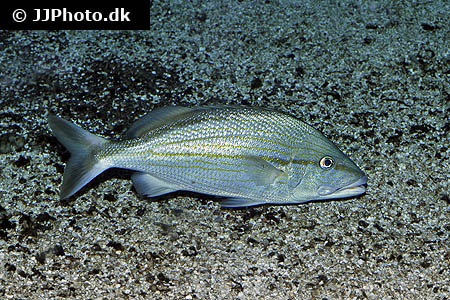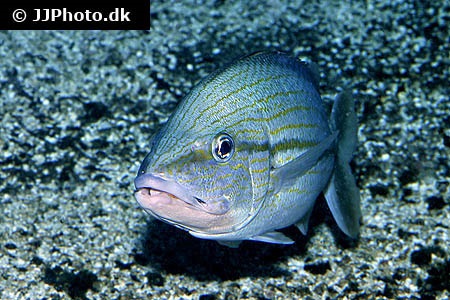Haemulon melanurum


| Latin name | Haemulon melanurum |
|---|---|
| Local name | Cottonwick grunt |
| Family | Haemulidae - Haemulon |
| Origin | The Mexican Golf, West Atlantic |
| Max length | 33 cm (13") |
| Minimum volume | Unknown |
|---|---|
| Hardiness |
Unknown |
| Suitable for aquarium |
Unknown |
| Reef safe |
Unknown |
| Aggressiveness | Unknown |
| Mostly |
Fish Larger crustaceans (Shrimp, crabs...) |
|---|
There is little available knowledge of this species, so there can be important information missing on this page.
This species is venomous, but it´s toxin is rarely dangerous to humans. It can however cause considerable pain.
In case of poisoning it is vital to have as much information as possible regarding the species/poison. Have telephone numbers for the poison hotline close to the aquarium.
Since different people can have different reactions to poisons, take precautions necessary to ensure personal safety and that of the surroundings.
This poison can be dangerous if suffering from allergies.
Fish within in the Grunt family do not often appear in private aquaria, but can be kept in a very large tank under proper conditions. They are predatory fish and mostly live off benthic crustaceans, worms and fish.
There can be a big difference in appearance when the fish is young and fully grown.
This family can divided into two groups: Plectorhinchinae (Sweetlips) and Haemulinae (Grunts).
Aquarists normally find Sweetlips to be the best looking, but they can be difficult to feed and it can be problematic giving them food containing enough nutrition. Grunts are more hardy and quicker to start feeding in aquaria.
It can be a good idea to have live food, Mysis or small live freshwater shrimp, in case these fish don't begin to feed.
One should not acquire these fish with the intention of selling them on when they get bigger. This is, not only because they grow quickly if fed correctly, but also because they are difficult to sell on to domestic buyers.
Sweetlips include the genera of Diagramma and Plectorhinchus.
Grunts include the genera of Anisotremus and Haemulon.
Bob Fenner. Grunts, Porkfish (Excluding Sweetlips), Family Haemulidae - Wet Web Media - (English)
Scott W. Michael. 2004. Angelfishes and Butterflyfishes (Reef Fishes Series Book 3) TFH Publications / Microcosm Ltd. - (English)
Bob Fenner. Indonesian Grunts & Sweetlips, Family Haemulidae - Wet Web Media - (English)
WWM Crew. FAQs on Grunts, Sweetlips, Family Haemulidae - Wet Web Media - (English)

